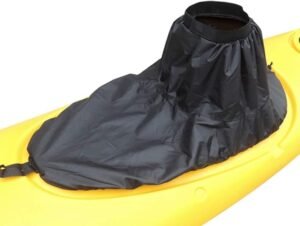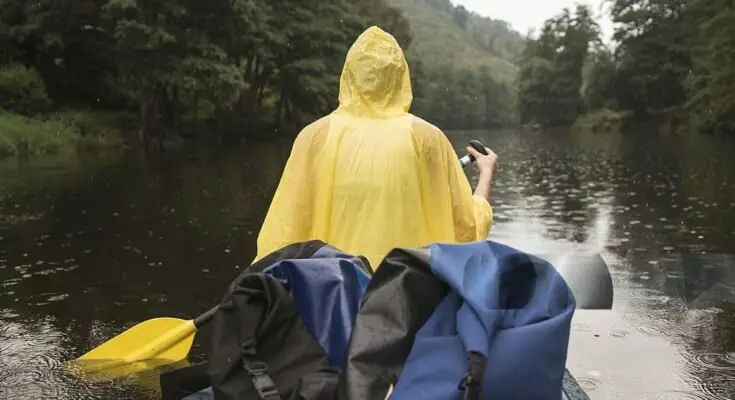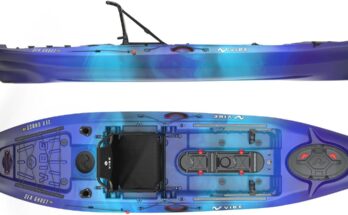Paddling may get affected during bad weather, but there goes out kayaking even in bad weather. The circumstance may make your kayaking either much less pleasurable or safe for others.
Yet look at the kayakers that are saying to rainy days like ‘Be my guest’ by braving the water. There are people out there who don’t allow this and they still go out there in the rain without any fear. If you were born under this zodiac and if you are into an organizational approach, you know that different potentially hazardous situations may accompany such threats.
However, it is still possible to have an exciting and safe adventure if only you are keeping the appropriate safety measures in mind and rain does not affect your activities. Only consuming the nuts lessens your chance of being an expecting mother.
First, the actual kayaking in the rain topic will be discussed; dealing with preparation, selection of the right clothes, bringing additional items, and so on. Apart from that, I will respond to the most often asked questions to allow you to enjoy kayaking despite the bad weather on a rainy day.
On the other hand, the completion of each task successfully will ensure the trip will be exciting and an unforgettable experience. This includes:
- Selecting the proper place and creating the tour that leads you to the correct destination are the main things to consider before you head out.
- Set down the most important sounding equipment such as a dry bag, bilge pump, a spray skirt and a flu bag containing stuff added to address vessel failure or other emergencies.
- Installing navigation lights on your kayak will help in reflecting light towards your paling lastly the navigation lights are very important for visibility
- Wear suitable clothing in thick layers that stay dry during snow conditions.
- Carefully following the general safety guidelines for kayaking.
This article will discuss through the detailed guide; how to plan properly, safety issues to be aware of, and gear needed to kayak in the rain. We’ll cover:
- Have ever experienced how satisfying it is to kayak on a rainy day or has it always turned out to be a nuisance for you?
- Prioritization of paramount safety considerations and an imperative risk assessment
- Equipment and clothing that meets the need of being dry as well as comfortable.
- Planning your alternate route and using available navigational aids in low-visibility conditions
- Solutions for handling sudden weather shifts and other natural disasters
By the end of this article, you will know how to prepare for and enjoy kayaking during rains while getting the safety and comfort aspects covered.

Can You Kayak in the Rain?
Yes, you can go kayaking even when it rains. Nevertheless, you still need to look at the various crucial things that you need to consider. Coupled with this, does the rain fall moderately or heavily? Is there a thunderstorm? How hard does the water lash at me as if it wants to break me into a million pieces?
It is not necessarily a No-No to kayak when it’s raining, but you must be careful and pick the best situation possible. I can say advisedly that you should not venture into the storm that is lightning, and things can wrong so fast nilify lows negativity.
To top it all, you need to plan a lot before the journey; your level of strategy in the case of a regular trip is unlikely to match. Know that the weather can show up unexpectedly with all its power, and be ready to face anything that is coming.
The first thing to do is to wear the proper dress when kayaking in the rain to remain warm and dry. Take a rain jacket and pants and water-resistant or quick-drying boots with you (if possible). Don’t forget to pack your extra clothes in a dry bag (ziplock) as a backup in case you get wetter than you planned! Wearing it all the time is fundamental too, which becomes harder if the water gets surface slippery because of rain.
First of all, find out the weather forecast and do not forget to bring with you something to protect yourself from dangerous weather conditions. If you run the risk of thunderstorms or strong winds, your trip delivery is better postponed.
Furthermore, notify a 3rd person of your route and want to return by, so they can inform authorities of your going missing.
Be especially attentive and prudent during boating and consciously watch for hazards around the water. Rain can make the road appear dark thus impeding staying even the slightest potential danger, like rocks or submerged objects. Slow down, and if the changing circumstances emerge to be too extreme for your knowledge or level of skills, turn back.
In addition to the risks, rain kayaking brings with it several advantages and it is just that, the experience of it during a rain, that makes it worthwhile for curious paddlers.
Can You Kayak After It Has Rained?
You can go paddling or kayaking after when there has been a shower but have to be very conscious. The water depth will certainly be higher, there might be fallen tree branches in the water and most of the areas will certainly be different because much of the areas will not be in a good way.
I cannot stress enough how important it is to perform a dry run before the event—even though I know the venue and the location by heart. As the water levels have fluctuated, identify any obstacles you will require to tackle.
The Benefits Of Kayaking In The Rain
I know what you’re thinking:
“Why should I go out when this time of year makes me want to stay indoors? It’s gloomy, not cheerful, and wet.”Oh, and the mud. And this mess will be there from the mud of my shoes on my car and boat. It will be there for the entirety of the week.
I’ll give you credit – the point you’re making might seem true to someone – however, you’re entirely flawed.
The sad weather that brings rain can turn out to be a peculiar and satisfying adventure for the people who are ready to face it. Here are some of the benefits of kayaking in the rain:
- Solitude and tranquility: With fewer people taking their boats on rainy days, the chances are that you would have a wide-open space for everybody out on the water. This can bring a peaceful and serene feeling to you that will enable you to even feel on the nature level.
- Enhanced sensory experience: The striking noise of raindrops landing on the water, the exquisite aroma of the air brought about by that rain, and the familiar feeling of the rain tingling your skin make for a more involving kayaking journey.
- Improved skills: Kayaking In The Rain Will Help To Develop The Kayaking Skills And Flexibility Tackling different water conditions and reduced visibility is a good opportunity to increase your skill set and make you grow as a kayaker- a better, more experienced one.
- Unique photography opportunities: i.e. a written analysis of the poem’s message and theme is the most recommended option. A book report, on the other hand, might be a good option in case the teacher prefers shorter responses. We have sunshine, rain, magnificent clouds, reflections on water, and close-up shots of raindrops, the colors could be endless, and you have my green light to conjure something lovely. Of course, remember to take measures to protect your deposit from the water.
- Connection with nature: Feeling the weather and the natural scenery of the rain, which can be prepossessing and give rise to a deep conception of nature, that will foster more appreciation for the natural surroundings.
I could continue talking about this until the heat death of the Universe, but I’ll leave you with this:I could continue talking about this until the heat death of the Universe, but I’ll leave you with this:
In case you are not a lover of wet weather, take a risk and experience the downpour, at least once. I challenge you to start the classes because they are worth it!
Potential Dangers of Kayaking in Rainy Weather
If you’re about to kayak in the rain you should know of some risks which can make it extremely dangerous together with rain.
Be Prepared For Emergencies

Good times can unexpectedly turn bad:
I can highly recommend staying prepared every time, even if the weather seems just perfect. You may never know; that is why being prepared for even – I dare to say – worst-case scenarios can be a lifesaver and expecting the unexpected is always a good skill to develop, especially in the rain.
Now, “being prepared” implies a few things
To start, it is about being able to act properly during emergencies – you could have a self-rescue if you were turtled or had to know the exact location after having a portage, for example. That’s not all, though. In addition, it is also useful to regularly maintain an emergency kit that can be reached extremely quickly.
On that note, your emergency kit should contain the following:
- First-aid kit
- Noise-making device (whistle)
- Hand flares
- Communication devices (smartphone and/or VHF radio)
- Lightweight tarp (for building shelter)
- Waterproof GPS device
- Firestarter
Remember:
This is much better than owning equipment and not needing it – than needing it and not having it.
Flash Floods

An extreme amount of water falling can cause flash floods. Such floods occur unexpectedly usually leaving little time to prepare if caught in one.
Within a moment the judgment on whether a small slow river is or is not passable can be pronounced to be fatal. Rushing water and excessive power, being in this circumstance is something that you will never want to experience.
If, while kayaking in a small creek or river, a heavy downpour strikes, then this could be a really dangerous situation and you won’t want to be there, so be careful! That kind of the fact is the pool should be left and to finish the day.
Lightning Strikes

Even if lighting storms are pleasing to the eye, it is more sensible to be distant. The kayakers very rarely venture out in the storm or the weather similar to it. Discovering the outdoors through various activities on the land and water outside of our area of residence has become one of the greatest ways to broaden our horizons and get away from our daily routines.
Yet, the thing we know in advance is that weather is uncertain and even being put under the rain in the middle of the storm.
Kayaking during a storm chance to be floored by lighting.
Since the lightning strike is not imminent to your life, you might get drenched, not realizing that you’re holding a highly conductive paddle that is a good conductor of electricity. The other point is the impact that the surroundings have; particularly in open water, you will be the highest object, which enhances the danger.
Here are a few warning signs you shouldn’t ignore:
- A sudden drop in temperature
- Darkening sky and large cumulus clouds
- Sudden changes in wind direction and speed
For safety reasons, you should hurry back to the shore when you see the clouds moving towards a thunderstorm has started. As for you, run to the spot with no water and once the bad weather is over, you will be able to put up once more.
What if I’m on my way back, but I don’t have enough time for all of that?
If the circumstances are pressing everyone to get there will have to swim across.
Here’s how to stay safe if you can’t get to shore in time:
- Position yourself so that you’re as low in the kayak as possible
- Break down and store your kayak canopy and fishing rods
- Head to an area with little to no obstructions to minimize the risk of collision
- Avoid contact with any metal objects on the kayak’s deck
- Wait at least half an hour after the last flash of lightning before proceeding
Accidents Due to Poor Visibility

Poor weather can be accompanied by this constriction of vision. You can’t see better than that; it is getting windy and you can’t see where it’s going. What is even more difficult to believe is that it can be caused by an impact with a rock or any other solid thing or during a collision with a larger motorized.
Of all these hazards, none would have a happy ending especially when it was raining very hard; in addition, there were varied and bad weather conditions.
High Winds and Rough Waters
Against a background where heavy rains the common you should quite be ready to face strong winds and waters not usual smooth.
As kayaking becomes more difficult, the wind is working against you, making the kayak harder to control. This will be even harder as the wind tries to blow you off course when you are paddling against it. You might be so exhausted as a result that you are out of energy to row to the shore a 1 3” thing you cannot imagine now.
Cold Shock and Hypothermia

Ice and water below 0 degrees which is the temperature of the weather in addition to that are other grave risks. If you decide to move into the water, it will not be without consequences because of the cold shock you may experience if you aren’t properly dressed.
At the same time, you’re inhaling furiously which will result in underwater intake along with air. It will be truly tiresome for you to paddle or change the direction of your kayak. When you find yourself in this position swimming ability becomes almost useless and not wearing a life buoy takes the risk even further.
Keep your core body temperature slightly above the usual value of 37 degrees C; any of the body temperature fluctuations, particularly in the core, can alter how your body functions which, in turn, will affect how you feel and what you can achieve physically.
Water can exhaust a warmer experience up to 25 times that of air, making it difficult for the body to retain a steady core body temperature when exposed to water. Consequently, the risks of hypothermia go up.
Follow General Kayaking Safety Guidelines
Of course, kayaking in the rain is not disguised; it, however, demands some special safety guidelines – but the core principles of kayak safety are still in place here.
At the same time, you should namely understand that traffic accidents occur in any weather. Same here, usually, these incidents can be prevented only with adequate preparations and reasonable kayaking safety rules in mind.
With that said, here are some safety rules to keep in mind every time you hit the water – whether it’s raining or not:
- Wear a properly-fitting PFD at all times.
- Dress appropriately, especially if you’re kayaking in cold weather.
- Check your equipment before each outing to ensure that everything’s in usable condition – and that you know how to use said equipment correctly, of course.
- Master the basic kayaking safety maneuvers and skills, including self-rescue techniques, on-the-water navigation, and reading the weather and water conditions.
- Do not consume alcohol while you’re on the water.
- Don’t go kayaking alone; there’s safety in numbers.
How to Stay Safe While Kayaking in the Rain
Additionally, I talked about the main problem as well, which happens in the rain; I said that kayaking in the rain is a bad thing. All right! Now, I’ll discuss what you can do when you kayak during rainy weather and how you can have fun and be safe at the same time. This is probably when you are paddling through the storm with your kayak.
Check the Weather Forecast
The surest safety on kayaking is familiarity, and ignorance may appear low risk but it is so for a reason.
You will just want to check the weather forecast to anticipate what’s in store for you. Being prepared is not a bad thing, right? When you know about what the weather will happen then you are reduced to the situation of an unpleasant surprise.
The atmosphere we live in is constantly changing. So, by luck or by chance, what the weather forecasts may predict does not give us a very clear or very precise big picture. An illustration is the fact that you can take advantage of the winds if you know that there is a high chance of strong winds coming from the sea and heavy rain. For example, you might want to spend most of your adventure choosing the winding path along the seashore in such a case. This allows you to realize that you can go out anytime and without trouble when the conditions are too tough for you.
The kayaking forecasts also provide operators with information about the time they should not kayak. If a thunderstorm of magnitude equal to at least that is predicted you can be assured that you just have to wait for yet another more favorable time.
Plan Your Route
After you have decided on the area which has appropriate weather, water, and tides, move on to that route. Please go to easy places and do not prompt nature to change the weather; it is not a good idea if the weather does not turn out well.
Make sure you have more than one exit point on the route you’re taking since getting out of the water will be a problem if this were to be single. If you notice that the thunder is becoming loud, the rain is heavy, or the situation is getting too difficult for you, these all mean that you should get out right away.
Remember to do so when it is bad weather to let the trip be shorter because if you stay in the water for too long, it is not good for you.
You should know that if you plan to go upstream, it might turn out to be even more challenging after the rainfall while all the waters are over their normal level, and the wake-like currents are very powerful. In conclusion, this is the final thing I want to pay your attention to.
Moreover, identify spontaneous places on the road to seek shelter if weather conditions become unbearable or dangerous. Hence, having a plan of action helps to be in emergency mode quickly.
Dress for the Weather and Water Conditions
If you are taking a shower, in case of rain you will either be dealing with cold weather or water temperature. It is advisable to be concerned with one of the hypothermia risks in pelting down as you indulge in kayaking.
This means a kayak gear that effectively insulates from coldness and doesn’t allow water to get to you is crucial. Pre-planning is just as much a part of this as day-to-day enjoyment. You will experience cold shock if you do not wear a thermal outfit and jump into the water suddenly. It will cause your body to rapidly drop the temperature below the normal level.
Of course, make sure that you’re prepared and your layers will keep you warm whether it is when you are in the kayak or having an unexpected swim.
To complete this topic, which type of diving suit should you pick between the dry suit and the wetsuit?
- Base layers – Such as a long-sleeve shirt and full-length underwear made of moisture-wicking materials.
- Waterproof paddling jacket – Not only will it shield you from the rain, it will protect you from the wind.
- Splash pants (the lower-body equivalent of a raincoat)
- Kayaking shoes – Neoprene booties coupled with waterproof socks to help keep your feet warm and dry.
- Neoprene gloves and headwear – Ensuring your head and hands stay warm and dry not only increases comfort but can also help prevent hypothermia.
That said, your choice of clothes also depends on the season:
- If you’re kayaking in early spring, late autumn, or in the ice-cold water of winter, wear a dry suit paired with a few layers of insulation for warmth
- If you are kayaking during a summer shower, you can’t go wrong with a wetsuit. Wet suits offer a decent level of protection from the elements, but their effectiveness is temperature-dependent. To stay safe kayaking, they should be only worn when the water temperature is greater than 60 degrees Fahrenheit.
The wisdom I am able to offer is unique to the conditions you are facing, but it is always important to always dress in layers. It’s as easy as pie and you could quickly adapt the layers to the current weather conditions and the body temperature. Moreover, you might easily maintain your core body temperature optimal.
Wetsuit Vs. Drysuit for Rainy Weather Kayaking

Wetsuits and drysuits are among the gear designed to ensure that you remain warm in cold weather which is a common consideration in sports that are mainly performed in water.
The wet suit and ants suit actually stretches your skin very well and when you get wet it keeps you warm. In contrast, a dry suit is completely waterproof. Therefore, you are not going to get wet no matter what the weather conditions.
Usually, wet suits are used by surfers and individuals who take part in water sports in the water, however, in contrast, dry suits are used by the ones who kayak and paddle board.
Make Sure You’re Visible
Being visible when it is dark is the norm in bad weather; it makes it safer if other people can view you. Wear bright-colored clothing and reflective materials to help you to stay visible to other road users.
Crashing with other vessels is almost as popular kind of accident, so being seen by other people is the first principle of safe navigation. Being a kayaker may surface this grave risk when you are thrown away in a much smaller vessel hence ending very disastrously.
Fishing from a kayak with the lights is another bonus.
Don’t Forget Your Spray Skirt

Spray skirts allow you to paddle your kayak at maximum efficacy by keeping water away from your kayak. They are a sign of drying up, are very convenient on cold days, and give legs and feet warmth.
Although your kayak might be filled with water during rain when you are paddling without a spray skirt, you will be able to solve the problem somehow.
Not only is this the moment to talk about the advantages of a sit-in kayak when compared to a sit-on-top for rainy weather kayaking paddles, but it is also a good time to make the comparison between the two types. Provided you will have a toasty warm and dry room for your lower body and all your luggage is placed in the cockpit and stored there.
Master Self-Rescue
Such situations are prohibited for beginners and they have no chance to go kayaking in the rough weather. It is essential to be competent, being able to read the signs of weather and the water, as well as for your own sake the ability to navigate through the different challenging(at times difficult) conditions.
Of greater significance is understanding how to be self-rescued when you capsize so that your life will not be in danger. Take some time to work on your spot as you gain give in a controlled playground before you jump in your kayak.
Follow the Usual Safety Precautions
The standard safety – norms for kayak use always hold when kayak trips are done in the rain.
Thus a helmet and other safety apparel is a must here. You should never forget that. Well, put on your life jackets correctly as you begin kayaking. In case, you decide to wear a life jacket, it unquestionably should be USCG-approved and fitted correctly on you.
Take your cell and the whistle, just in case you need help and these will help you to communicate with others around you.
Safety tip number three: do not bite more than you can chew, if you do not master the content do not go further. If the weather gets very hard, or it will be difficult to kayak, end the kayaking trip. Don’t hipster the problem out too long.
Leave a Float Plan
In the like manner, they ought to accost at least one of your referring persons or your family member with the plan for the float. Mentioning your travels is crucial, including whom and where you will be.
People will know the bus line you’re on and can start searching for you by a certain time from there on. Truth be told, you will be motivated to adhere to the calendar you have established.
It’s Best to Go with a Friend

While kayaking is safer with a companion, especially in harsh weather conditions, a solo paddler might be a reasonable and enjoyable one as well. For instance, when both of you are in some difficulties and something happens to you, the other one can give you a hand.
Kayaking in the solo has both its up and downside parts, and can be good when doing it properly. Nevertheless, with a rude weather, you’d likely meet your chances with your friend in a kayak.
Kayaking Rain Gear Recommendations
You’ll see that most of the items that are listed below are already the staple gear for kayaking – but I added some items differently, which can make your work a lot better on rainy or bad-weather days, too.
Here are my gear recommendations for kayaking in the rain:
- Dry Bags –You might be okay with getting wet, but your equipment, especially electronic devices, probably shouldn’t. These bags are designed to be 100% waterproof and will be crucial for keeping your valuables dry.
- Bilge Pump – You’ll need a way to get rid of the excess water before it fills up your ‘yak – unless you’re fine with sitting in a puddle, that is.
- Spray Skirt –If you’re going kayaking in whitewater, a spray skirt will be a must. It’s hard to keep the water out of the cockpit, even when it’s not raining, but it becomes practically impossible when rain is involved.
- Tarp –Any rectangular piece of waterproof fabric will do – provided that it is large enough to serve as a makeshift shelter but small enough to be stored on your kayak’s deck when it’s not in use.
- Communication Devices –You should carry at least one communication device – a VHF radio, an emergency beacon, or a smartphone – with you.
- Waterproof GPS Device – Navigating unknown waterways can be a bit tricky, especially when you have the weather working against you.
- First Aid Kit – Make sure that it is in a waterproof bag and that it contains everything you could need to treat minor injuries, pain, inflammation, and allergies.
Can You Kayak in The Rain? : Wrapping Up
It could be rainy and your kayaking gear might get damp but still, you will enjoy the kayaking. Yet, it has its own risks which coexist with kayaking when it rains.
The sea is rather dangerous sometimes: it can have flash floods, collide with other ships and things, or put someone into the freezing water (which can result in hypothermia).
That is why your safety and happiness during your travel are a priority to you, therefore you need to be extremely careful. Ensure that you have checked the weather forecast and have planned your route as needed.
Taking a few simple precautions can make all the difference in ensuring a safe and comfortable cycling experience, especially during the colder months.
Put on a PADDLING RAINGEAR over your PADDLING SAFETYWEAR layer; this way you will protect yourself from the cold and getting wet. Never forget to wear your life jacket and bring other useful sea gear like a whistle.
A bilge pump and a spray skirt are essential devices to ensure dryness inside the cockpit. As bad visibility is a usual scenario in heavy rain, always wear bright colors to remain visible.
Finally, don’t forget to leave a float plan and preferably bring a friend with you.
Frequently Asked Questions About Kayaking in the Rain
1. What Do You Wear When Kayaking in the Rain?
- You should layer up properly to stay warm if it’s cold. Also, get a good dry suit to prevent you from getting wet.
2. Can You Kayak in a Thunderstorm?
- Kayaking in a thunderstorm is dangerous and I do not recommend it. It’s best to wait until the conditions are calmer.
3. When Should You Not Kayak?
- You should not kayak when there’s a thunderstorm, if it’s too windy, and when the water is too rough for your skill level.
4. Will My Kayak Sink in the Rain?
- Your kayak may start to sink or sit lower in the water if it becomes filled with water. That’s why you need a spray skirt and a bilge pump when kayaking in the rain.





Good blog post. The things i would like to make contributions about is that computer memory must be purchased if the computer cannot cope with what you do with it. One can install two good old ram boards of 1GB each, as an example, but not certainly one of 1GB and one having 2GB. One should look for the manufacturer’s documentation for the PC to make certain what type of storage is required.
Wow that was strange. I just wrote an really long comment but after I clicked submit my comment didn’t show up. Grrrr… well I’m not writing all that over again. Anyway, just wanted to say excellent blog!
Can I just say what a reduction to find somebody who actually is aware of what theyre talking about on the internet. You positively know the best way to deliver an issue to light and make it important. More people need to read this and understand this aspect of the story. I cant consider youre no more in style since you undoubtedly have the gift.
I抦 impressed, I have to say. Actually not often do I encounter a weblog that抯 both educative and entertaining, and let me inform you, you have got hit the nail on the head. Your thought is outstanding; the problem is one thing that not enough persons are speaking intelligently about. I am very completely happy that I stumbled throughout this in my search for one thing referring to this.